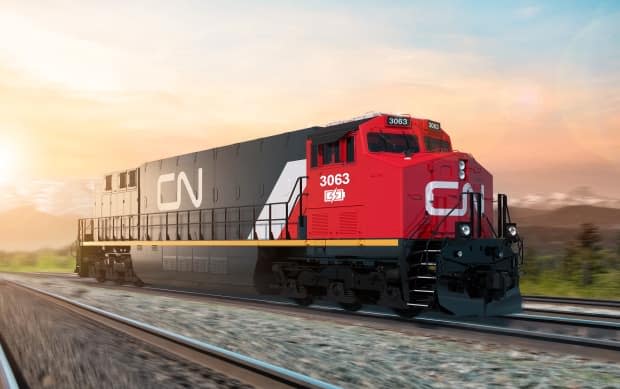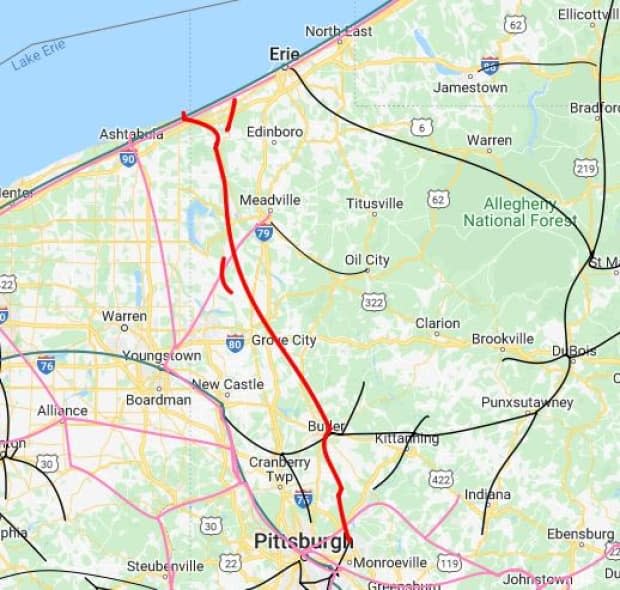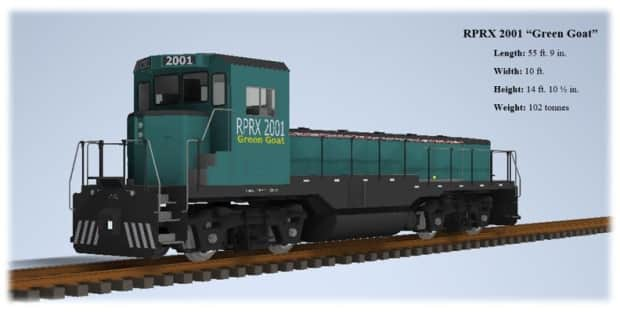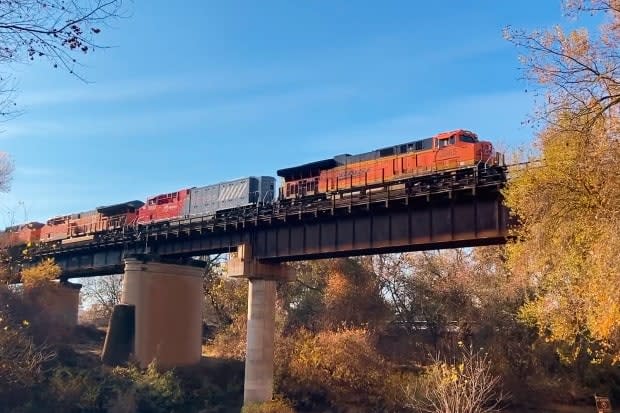Hauling freight trains with electric locomotives is now starting to happen

Our planet is changing. So is our journalism. This story is part of a CBC News initiative entitled "Our Changing Planet" to show and explain the effects of climate change. Keep up with the latest news on our Climate and Environment page.
Canada's railway giants, CN and CP, are testing battery and hydrogen locomotives in a move toward electric, zero-emissions freight rail. At least one smaller railway, Southern Railway of B.C., is working on hydrogen locomotive technology too. Here's a look at why they're electrifying and the technologies they're testing.
Why the industry is moving toward electric
Though the transportation sector is the second-biggest source of greenhouse gas emissions after oil and gas, the Railway Association of Canada says rail generates only 3.5 per cent of transportation emissions.
Still, said Josipa Petrunic, president and CEO of the Canadian Urban Transit Research and Innovation Consortium, given Canada's ambitious greenhouse gas emissions targets, even those need to be eliminated. Rail companies are now facing pressure from both governments and shareholders to reduce emissions, she said, especially now that the price on carbon is expected to ratchet up over time — and, with it, the price of diesel that powers Canadian trains.
"They know they've got to cut this cost before it starts hitting their bottom line," said Petrunic, who co-authored a 2020 report on rail innovation in Canada.
Gord Lovegrove, associate professor of civil engineering at the University of British Columbia Okanagan, agreed that there is increased shareholder pressure on railways to address climate change.
"And that's why [electrification] is happening in advance of any federal regulation," he said.
But he noted that diesel-burning trains also generate a lot of other pollutants that are bad for human health. These include nitrogen oxides, fine particulate matter, as well as sulphur dioxide linked to acid rain.

In urban areas, these pollutants and the noise generated by locomotives can be a huge nuisance near switching yards, which is where rail cars are stored, loaded, unloaded and hitched together. The small switcher locomotives that move cars around in those rail yards represent just a fraction of Canada's locomotive fleet, Lovegrove said, but can generate double or triple the emissions of a long-haul locomotive engine.
The B.C. government has started to charge fines for older, more polluting locomotives, he said. But it has promised to return the last three years of fines back to Southern Railway of B.C., if it retrofits its locomotives to include zero-emission technology.
"So not only are they realizing reduced fuel costs, reduced public complaints [but] they're getting money back to fund their business case," Lovegrove said.
In the longer term, given climate and pollution concerns, he said, rail companies need to electrify "because diesel is going to be regulated out of existence."
CN's battery electric locomotive project
CN Rail, headquartered in Montreal, announced in November that it had purchased a Wabtec FLXdrive battery-electric heavy-haul freight locomotive. The company has set a target of reducing its greenhouse gas emission intensity by 29 per cent by 2030 compared to 2015 — and achieving net zero by 2050.
Janet Drysdale, CN Rail's vice-president of sustainability, said 85 per cent of the company's emissions are produced by its diesel-powered locomotives.
"So solving this locomotive issue is really critical for us."
The plan is to test it on a small, isolated piece of track near Wabtec's headquarters in Erie, Penn. The company has received funding from that state for the pilot.
This particular locomotive was tested in California in 2021. But Drysdale said because CN operates in Canada, one of the things that needs to be tested is how the battery is affected by cold.

Battery-electric locomotives have been tested in train yards, but the CN/Wabtec pilot will also do tests pulling freight on the main line.
CN said the electric locomotive, which will operate along with up to six other locomotives, could reduce emissions by up to 30 per cent on routes where the topography allows it to partially recharge the battery with regenerative braking. Regenerative braking recovers some of the energy used to slow down the vehicle and turns it into electricity.
In the future, Gina Trombley, executive vice-president and chief commercial officer for Wabtec, said the companies expect most of the recharging to happen via overhead catenary wires and pantographs, similar to those used by streetcars, during low-speed loading at locations such as grain terminals.
"In order to fully operationalize fully electric locomotives, you're going to have to find a way to charge on the move," she added.

Trombley said the CN project is still at the design stage, but the two companies think they'll have the locomotive running in the second half of 2023.
CP and Southern Railway of B.C.'s hydrogen locomotive projects
Calgary-based Canadian Pacific announced in December 2020 that it planned to develop North America's first hydrogen-powered line-haul freight locomotive. Nearly a year later, it said it was expanding the program from one to three locomotives after receiving a $15-million grant from the Alberta government. The fuel cells for the first locomotive were delivered by Vancouver-based Ballard Power Systems in January. Structures and logistics company ATCO Group announced this week that it had reached a deal to build two hydrogen production and refuelling stations, one in each of CP's rail yards in Calgary and Edmonton.
CP declined to be interviewed for this article, but in an interview on Ballard's website posted in September, Kyle Mulligan, chief engineer at CP, said initial trials are expected to run between Calgary and Lethbridge.
Kate Charlton, vice-president of investor relations at Ballard, said the company's fuel cells are already running passenger trams in China and being tested for passenger rail with Siemens in Germany. But ones required to haul freight are roughly double the size.
However, she said the fuel cells are similar in size to the diesel engine currently used to power the train's electric powertrain.
"So they basically pull the diesel engine out and replace it with a fuel cell," Charlton said.
She added that fuelling times should be similar.
Mulligan told Ballard that CP plans to roll out hydrogen fuelling infrastructure "coinciding with our existing diesel fuelling operation locations."
Charlton, who works closely with CP, said the company expects the hydrogen locomotives to be running in 2023.

Meanwhile, New Westminster-based Southern Railway of B.C., a short line railway, announced last year that it was converting one of its switcher locomotives from diesel-electric to hydrogen-electric, in partnership with fuel cell maker Loop Energy and hydrogen storage firm Hydrogen in Motion. The locomotive has been dubbed the "Green Goat." Lovegrove and his group are involved in the research and development for that project.
Lovegrove said the fuel cells and batteries are coming this summer and fall, and the system will be tested over the next year or two.
Why are they testing different technologies? Is there one that's likely to dominate?
There are operational reasons why CP and CN think their projects make sense. For example, CN says it has an ideal testing ground near Wabtec's headquarters in Pennsylvania, and that state is providing some financial support.
CP's Mulligan said that the company chose hydrogen because "battery electric requires recharging that can take time that — from our current operation, which is diesel powered — we don't necessarily have a provision for," according to the Ballard interview.
However, it can roll out hydrogen fuelling at its Ogden solar farm, and there are natural gas refineries in the Edmonton area that can produce hydrogen.

Drysdale said there are only a small group of railways and suppliers in the industry. "So what we want to avoid is us all testing the same things, right?"
Across North America, different rail companies are testing different technologies for different applications and in different local conditions.
"All of this work ultimately is going to benefit all of us," Drysdale said.
Lovegrove said batteries "will be a constant throughout" — whether they're charged by hydrogen fuel cells or some other method.
However, he thinks hydrogen will be a key technology when hauling heavy loads over long distances.
Petrunic said she expects there to be a mix of battery-electric and hydrogen-electric locomotives.
"There's going to be those switch yard locomotives and several regional rail routes that may make sense mostly with battery alone," she said, "and then others where hydrogen is going to have to be the solution because [of] not only the range, but the availability of fuel."
She called both CN's and CP's projects "baby steps in the right direction."
"But," she added, "these baby steps are going to basically end there unless there is a very significant effort to build out both the electrical capacity across the country for this, as well as the hydrogen supply chain."

